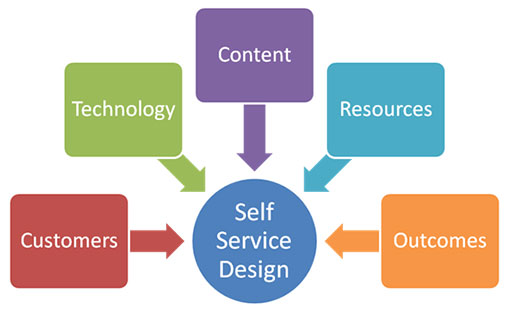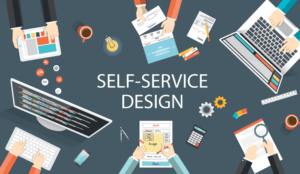Martin Jukes takes us through some of the key design considerations for delivering excellent customer service through self-service.
Delivering effective and efficient customer service through self service and automation is a real opportunity for many organisations.
There are many examples of where this has made a significant impact on improving the customer experience, increasing efficiency, reducing cost and made a positive contribution to both service provider and customer.
Self-service is now part of our daily lives. Whether it is booking travel, paying for road tax or almost everything else that we do, there is an opportunity to serve ourselves.
Some of these services are online but other examples such as the supermarket, banks or fast-food outlets enable customers to serve themselves on-site through the use of technology. This can lead to shorter queues, greater consistency and a reduction in the number of people required to serve customers directly.
Many of these can be great investments that deliver real value. However, there are some implications that require consideration.
Many of these can be great investments that deliver real value. However, there are some implications that require consideration.
When looking at online transactions, the following diagram highlights some areas that need consideration in the service design process.

Customers
The service provided must meet the needs of customers and be accessible and easy to use. There is a need to identify who customers are and understand their experience and expertise levels of using technology. There are a number of considerations:
- Is the technology interface accessible to customers?
- Can all customer enquiries be met with automation?
- Is there a potential resistance to technology?
- Are there any customers with vulnerabilities that need to talk to somebody to discuss their issue?
Technology
The technology used in these applications has a high level of reliability, but there are always points of failure that are out of the service provider’s control.
There are many components between the end-user device (PC, smartphone, etc.) and the host systems that provide the potential for failure.
Failure of any of these components needs to be considered, as do a number of other factors:
- What happens when the technology or accessibility fails?
- Is the interface user friendly?
- Who will provide the technical support for the interface?
- What is the expected requirement for technical support?
- What happens when the inevitable user error occurs?
Content
The content of an enquiry often dictates the degree to which a service can be automated.
The content of an enquiry often dictates the degree to which a service can be automated. Ordering widgets online is easy, but what if there are different delivery addresses or the widgets are required at different times in different locations? To establish a sale, this may require a conversation to ensure that the right order is placed.
When there is an element of complexity, then it can be difficult to automate. For example, if a provided service is only partially required then this may be too complex to automate without significant development. There are only so many options that could be predictable, so there are sure to be some that are unique.
This complexity will often require human intervention, to be able to explore and discuss to reach a conclusion as to the best option for the customer. There have always been cases that have required escalation, but it may well be that this is now to a person rather than a senior person.
It is also probable that there may be exceptional requirements in terms of timescales and urgency. What happens when an emergency service is required or there are restricted access times?
Automation and Artificial Intelligence is great but there are some areas where it struggles:
- Problem solving
- Showing empathy
- Dealing with complexity
All of the above need to be considered in designing a service to enable a suitable outcome that is right for all.
Resources
As simple enquiries are automated it is likely that the contacts that require human intervention are likely to be more technical or complex. This means that the people that will deal with these enquiries need to be highly skilled in a number of areas, but specifically in the product offering, the user interface and having the ability to take ownership of an issue.
- What are the required skills to deal with enquiries that cannot be automated?
- Are these skills available?
- Can they be met with training and if so how?
- What are the correct remuneration levels for these skills?
It is likely that these people will be regarded as product or service experts and will be empowered to make decisions that meet the needs of the organisation and its customers.
It is therefore likely that these frontline staff will demand increased rewards in terms of salaries and benefits in the future.
Outcomes
Organisations implement automation for three main reasons:
- Improve the customer experience
- Maintain pace with the market
- Reduce costs
If we focus on cost reduction, then there are some obvious savings in resources required to deliver service to customers and the efficiency gained through having efficient processes (assuming that they were inefficient previously).
But there are a number of misconceptions that need to be addressed, particularly regarding the scale of an organisation, which may impact the opportunity to reduce resource. If additional channels are added then they need to be resourced.
There are a number of misconceptions that need to be addressed, particularly regarding the scale of an organisation, which may impact the opportunity to reduce resource.
I experienced a situation recently when trying to check on a delivery time where live chat was not available because all of the team were taking telephone calls. There was a long queue with a message recommending that callers use live chat.
Live chat is a good example of a misconception of efficiency. The theory is that an advisor can handle multiple chats at any one time, with three being a good benchmark. But what happens when there are not three chats, what if there is only one that is active?
While delays in conversation may be all right for a chat, they would not be appropriate when dealing with a call. Imagine that fragmented experience. So there is a need for sufficient demand to make it efficient.
It is essential that during the design stage the following questions are continually examined and used to ensure that the design is fit for purpose:
- What do we expect to see as a cost reduction?
- How will we measure the customer experience and customer satisfaction?
- What channels must we deliver service over?
- What will future channels be?
- What is the quality of data captured through automation like and is it sufficient for continuous improvement?
Summary

Martin Jukes
The use of automation and implementation of self-service is an attractive way to move forward.
However, to ensure that the benefits are realised and the outcomes are positive, sufficient care and consideration is required during the design stage to ensure that any solution is suitable for the service provider and, most importantly, the customer.
Are there any other design considerations that we may have missed?
If so, please leave your suggestions in an email to Call Centre Helper.
This article was written by Martin Jukes, the Managing Director of Mpathy Plus, the contact centre experts that support organisations in transforming their service.
For more on service design, try reading our article: Seven Top Tips for Service Design
Author: Robyn Coppell
Published On: 26th Mar 2018 - Last modified: 14th Aug 2025
Read more about - Customer Service Strategy, Environment, Martin Jukes, Self Service, Service Strategy






































